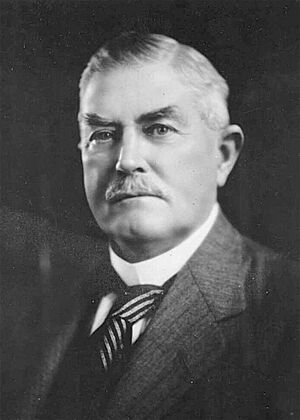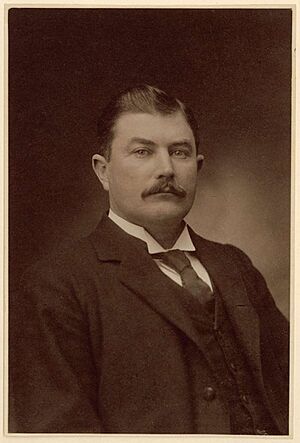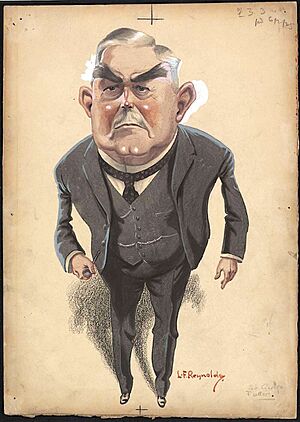George Fuller (Australian politician) facts for kids
Quick facts for kids
Sir George Fuller
|
|
|---|---|
 |
|
| 22nd Premier of New South Wales Elections: 1922, 1925 |
|
| In office 13 April 1922 – 17 June 1925 |
|
| Governor | Walter Edward Davidson Dudley de Chair |
| Preceded by | James Dooley |
| Succeeded by | Jack Lang |
| In office 20 December 1921 – 20 December 1921 |
|
| Governor | Walter Edward Davidson |
| Preceded by | James Dooley |
| Succeeded by | James Dooley |
| Federal Minister for Home Affairs | |
| In office 2 June 1909 – 29 April 1910 |
|
| Prime Minister | Alfred Deakin |
| Preceded by | Hugh Mahon |
| Succeeded by | King O'Malley |
| Member of the Australian Parliament for Illawarra |
|
| In office 30 March 1901 – 31 May 1913 |
|
| Preceded by | New seat |
| Succeeded by | George Burns |
| Member of the New South Wales Legislative Assembly | |
| In office 16 September 1915 – 7 February 1928 |
|
| Preceded by | Frank Badgery |
| Succeeded by | Mark Morton |
| Constituency | Wollondilly |
| In office 9 February 1889 – 25 June 1894 |
|
| Preceded by | Frank Badgery |
| Succeeded by | Mark Morton |
| Constituency | Kiama |
| Personal details | |
| Born | 22 January 1861 Kiama, New South Wales, Australia |
| Died | 22 July 1940 (aged 79) Darlinghurst, New South Wales, Australia |
| Political party | Anti-Socialist (1901–1909) Commonwealth Liberal (1909–1913) Liberal Reform (1915–1917) Nationalist (from 1917) |
| Spouse |
Ada Louisa King
(m. 1892) |
| Education | Sydney Grammar School University of Sydney |
| Profession | Lawyer |
Sir George Warburton Fuller (born 22 January 1861, died 22 July 1940) was an important Australian politician. He served as the 22nd Premier of New South Wales, which is like being the leader of the state government. He held this role from 1922 to 1925 and for a very short time in December 1921.
Before becoming Premier, he was a member of the federal House of Representatives from 1901 to 1913. During this time, he was the Minister for Home Affairs from 1909 to 1910.
Contents
Early Life and Education
George Fuller was born in Kiama, New South Wales. His father was George Lawrence Fuller. George went to Kiama Public School and then to Sydney Grammar School. He also studied at St Andrew's College at the University of Sydney.
He earned a Bachelor of Arts degree in 1879 and a Master of Arts degree in 1882 from the University of Sydney. After his studies, he trained to become a barrister, which is a type of lawyer who represents people in court. He officially became a barrister in 1884.
Starting in Politics
Fuller spent over 18 years as a member of the New South Wales Legislative Assembly. This is the main law-making body for the state of New South Wales.
He first represented the area of Kiama from 1889 to 1894. However, he lost his seat in the elections of 1894 and again in 1898.
Federal Government Role
In 1901, Australia became a federation, meaning the different colonies joined together to form one country. George Fuller was the first person to represent the Illawarra area in the new Australian House of Representatives. He served there until 1913.
From 1909 to 1910, he was the Minister for Home Affairs. This was part of Alfred Deakin's government. In this role, he was responsible for making Canberra the national capital of Australia. In 1911, he even represented Australia at the coronation of King George V in England.
State Leadership in New South Wales
From 1915 to 1928, Fuller represented the Wollondilly area in the New South Wales Parliament. He was part of the Liberal Party and later the Nationalist Party. In 1916, he became a leader of the Nationalist Party in New South Wales. He also became the Colonial Secretary, which was the second most important job in the state government.
In 1917, there was a big strike by railway and tramway workers. This happened because new "time cards" were introduced, which workers did not like. Fuller's actions during this strike caused problems with the unions. He offered better pay and benefits to workers who returned to their jobs. This split the railway unions for many years. His supporters believed his actions showed strong leadership during wartime. In 1919, he also expanded the state's fishing fleet to provide cheaper fish for people.
On 3 June 1919, he was given a special honour and became a Knight Commander of the Order of St Michael and St George. This was for his important work as Colonial Secretary.
Serving as Premier
After the 1920 election, the Labor Party won, and Fuller became the Leader of the Opposition. In 1921, the Premier, John Storey, passed away. Fuller took the chance to challenge the new government led by James Dooley. He won a "motion of no confidence," which meant the government lost the support of the parliament. Fuller was then asked to form a new government.
However, Fuller's first time as Premier lasted only seven hours! He lost another motion of no confidence, and Dooley became Premier again.
In the 1922 state election, Dooley's government was defeated, and Fuller became Premier once more. This time, his government lasted until the 1925 state election. During his time as Premier, his government started building the famous Sydney Harbour Bridge. In 1925, the Labor Party, led by Jack Lang, won the election, and Fuller's time as Premier ended.
Later Years
Soon after Jack Lang became Premier, George Fuller stepped down as the leader of the Nationalist Party. Thomas Bavin took over his role. From 1928 to 1931, Fuller served as the state's Agent-General in London. This job involved representing New South Wales in the United Kingdom.
Sir George Fuller passed away in the Sydney suburb of Darlinghurst.



